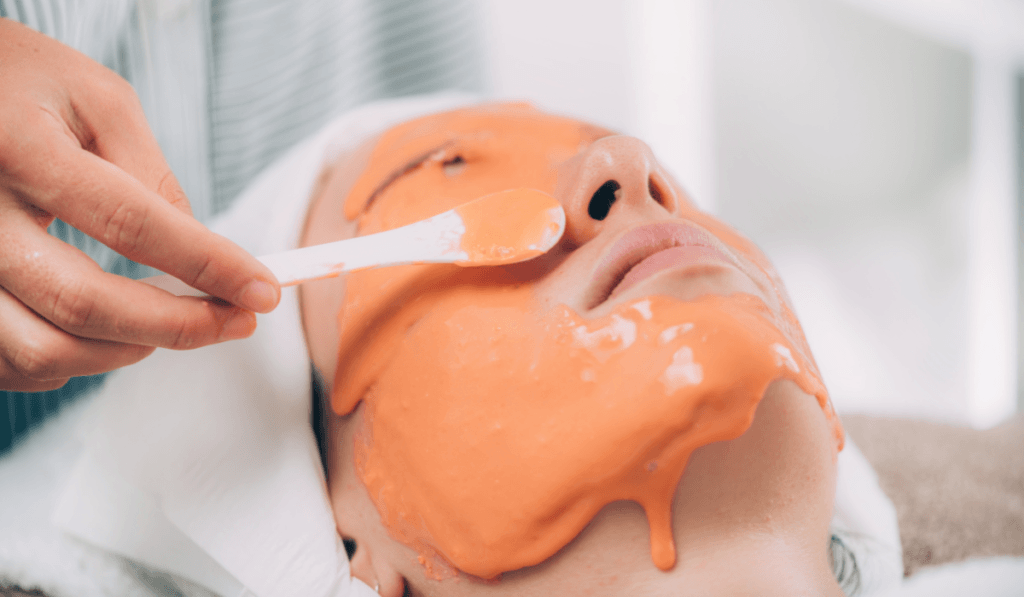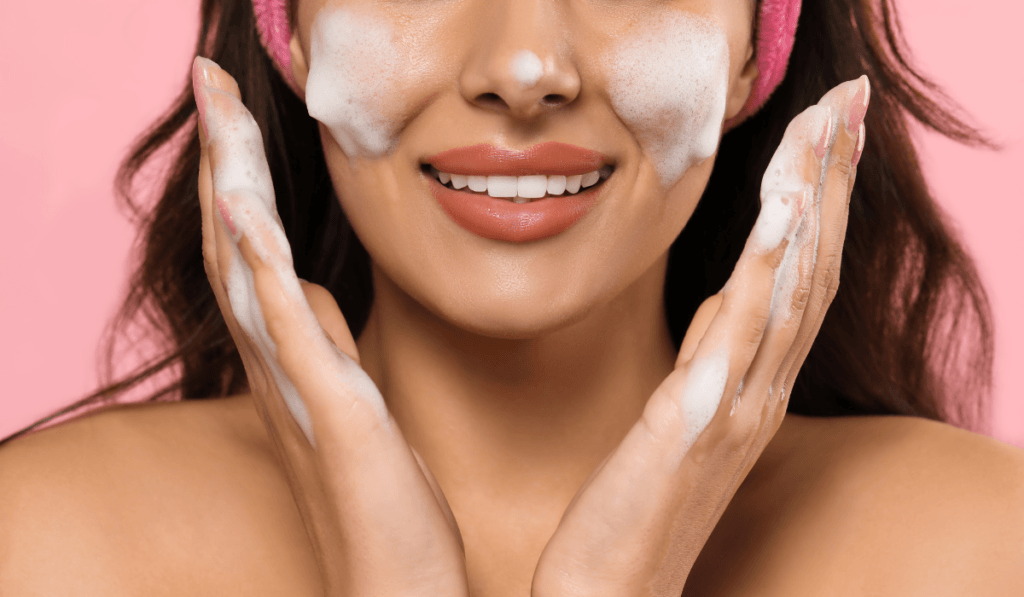Acne is a common skin condition that affects people of all ages and can significantly impact self-esteem and quality of life. Traditional treatments like topical creams, oral medications, and diet and lifestyle changes help many, but they don’t work for everyone.
Laser treatments have become a powerful tool in the fight against acne. These treatments use focused light to target and reduce the factors contributing to breakouts, such as bacteria, excess oil, and inflammation.
But there are several laser treatments on the market right now. How do I choose which one to try? What is the best laser treatment for acne specifically?
This guide will help you understand the available laser treatments and how they might fit into your acne treatment plan.
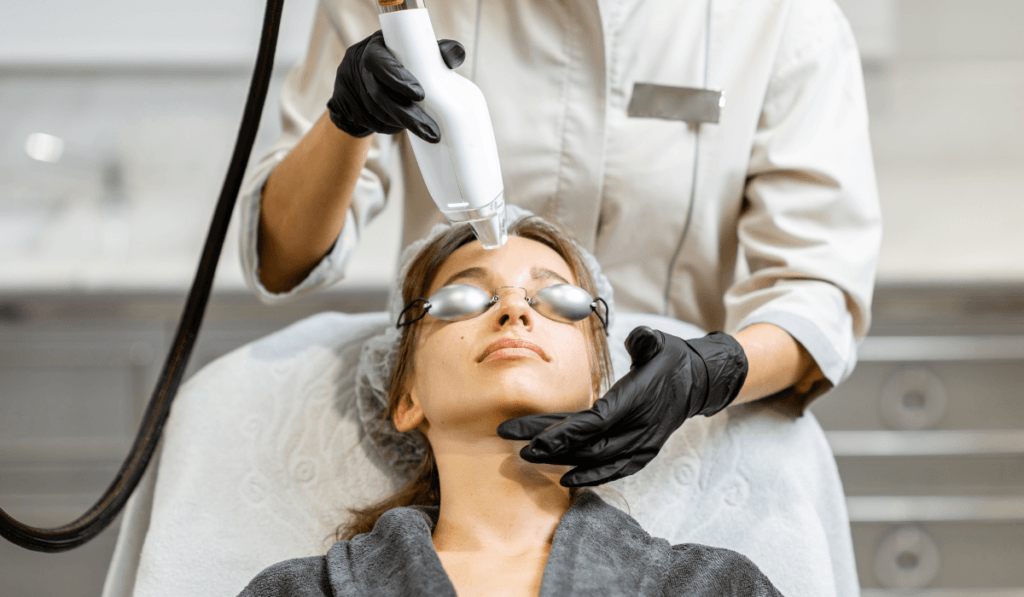
Alma Clear Skin (Harmony XL Pro)
- Technology: Combines an Erbium glass laser with contact cooling and vacuum technology
- Targets: Deep within the skin to reduce sebaceous gland activity, inflammation, and acne-causing bacteria
- Best for: People with moderate to severe acne and those with darker skin tones due to its non-ablative nature
- Number of Treatments: Typically 4-6 sessions spaced 4-6 weeks apart
Alma Clear Skin Technology is a standout in the world of acne treatments. Combining an Erbium glass laser with contact cooling and vacuum technology, this method targets deep within the skin.
By heating the deeper layers of skin, the Erbium glass laser can reduce sebaceous gland activity, which in turn can decrease oil production and reduce acne. It also promotes skin regeneration, which can help heal acne scars.
An Erbium glass laser is a type of non-ablative laser that uses a wavelength of around 1540 nm to target water within the skin. The term “Erbium glass” refers to the specific dopant (erbium) and the glass medium used in the laser to produce this wavelength.
The Erbium glass laser emits light that is absorbed by water molecules in the skin. Since human skin is made up of a significant amount of water, this laser can penetrate the skin’s surface and target specific layers without causing extensive damage to the top layer of the skin. This makes it a non-ablative laser, meaning it doesn’t remove or vaporize the outer layer of the skin but instead heats the underlying skin tissue.
Its non-ablative nature makes it particularly suitable for people with moderate to severe acne and those with darker skin tones. The technology minimizes the risk of hyperpigmentation, a common concern for darker skin.
A typical regimen consists of 4-6 sessions spaced 4-6 weeks apart. This treatment approach ensures comprehensive coverage and lasting results. While undergoing these sessions, one can expect minor discomfort, but most find it manageable. Your skin can be numbed before the treatment.
If you have been struggling with persistent acne and are looking for a solution, Alma Clear Skin might be worth considering. Consult with a dermatologist to see if it’s the right fit for you.
Aviclear Laser Treatment
- Technology: 1726 nm wavelength laser designed specifically for acne
- Targets: Reduces the activity of the sebaceous glands without damaging the skin’s surface
- Best for: Individuals with mild to moderate acne, particularly those who prefer a treatment with minimal downtime
- Number of Treatments: 3 sessions spaced 4-6 weeks apart
Aviclear is another innovative laser treatment option specifically designed for acne. Utilizing a 1726 nm wavelength laser, Aviclear targets sebaceous glands to reduce their activity without damaging the skin’s surface.
A 1726 nm wavelength laser emits light at a specific wavelength of 1726 nanometers (nm).
The 1726 nm wavelength is in the near-infrared part of the spectrum. This region is often used in medical and cosmetic applications because it can penetrate deeper into the skin than visible light, allowing it to target deeper tissue layers.
At 1726 nm, the laser energy is absorbed by specific chromophores (molecules or structures in the skin that absorb light), such as water and other components in the sebaceous glands. This makes it particularly effective for targeting and reducing oil production in the skin, which is a key factor in developing acne.
This treatment is particularly effective for individuals with mild to moderate acne. One significant advantage of Aviclear is the minimal downtime. You can usually return to your daily routine quickly after each session, making it a convenient option for busy lifestyles.
The typical treatment plan includes three sessions spaced 4-6 weeks apart. This approach ensures consistent and long-lasting results. Many users notice an improvement in their skin’s appearance after just a few sessions.
Aviclear stands out for its gentle yet effective approach to treating acne. For those preferring a treatment with minimal disruption to their daily life, this could be an ideal choice. Always consult a dermatologist to determine if Aviclear aligns with your skin’s needs.
Accure Laser Therapy
- Technology: 1726 nm laser with real-time temperature monitoring
- Targets: Selectively targets sebaceous glands to reduce oil production while sparing the surrounding skin
- Best for: Those with moderate to severe acne who want a more targeted approach to reducing oil production
- Number of Treatments: 3-4 sessions spaced 4-6 weeks apart
Accure Laser Therapy offers a targeted approach for those with moderate to severe acne. Utilizing a 1726 nm laser paired with real-time temperature monitoring, this treatment specifically targets sebaceous glands to reduce oil production, a major contributor to acne formation.
What’s unique about Accure is its precision. Focusing on sebaceous glands while sparing surrounding skin offers effective results with reduced risk of side effects. This makes it an excellent option for those dealing with oilier skin types and prominent acne.
Typically, a treatment plan involves 3 to 4 sessions spaced 4-6 weeks apart. This spacing allows the skin time to respond and recover between applications, enhancing the overall effectiveness of the treatment.
Accure’s precision and targeted method make it a compelling choice for individuals looking for a focused solution. If you have struggled with other treatments and are seeking something more specialized, Accure might be worth exploring with your dermatologist.
BBL Forever Clear
- Technology: BroadBand Light (BBL) with multi-pass light delivery
- Targets: Acne-causing bacteria, reduces inflammation, and promotes clearer skin
- Best for: Individuals with mild to moderate acne, particularly those who want to treat both acne and signs of aging simultaneously
- Number of Treatments: 3-6 sessions spaced 2-4 weeks apart
BBL Forever Clear is a versatile treatment option that uses BroadBand Light (BBL) technology to tackle acne. The multi-pass light delivery system targets acne-causing bacteria, reduces inflammation, and promotes clearer skin overall.
BBL uses a broad spectrum of light (hence the name “BroadBand”) to treat various skin conditions. Unlike lasers, which use a single wavelength of light, BBL emits light at multiple wavelengths, allowing it to target different layers of the skin simultaneously.
The light energy is absorbed by specific chromophores (molecules in the skin that absorb light), such as melanin in pigmented lesions or hemoglobin in blood vessels. For acne, BBL targets the bacteria responsible for causing acne (Propionibacterium acnes) and reduces inflammation and redness associated with acne lesions.
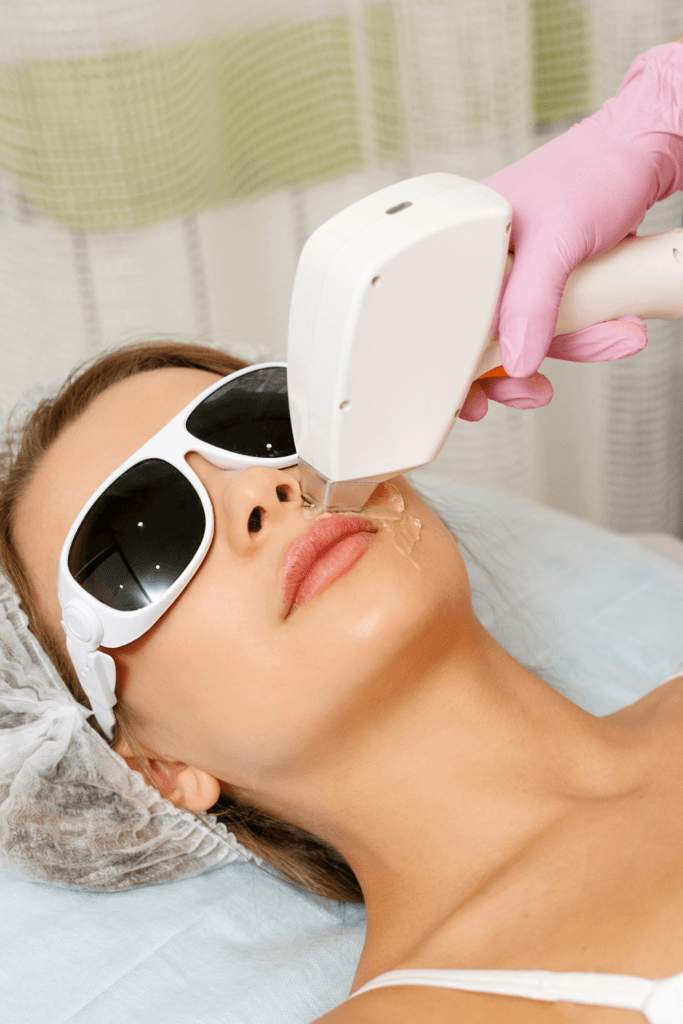
This treatment is particularly effective for individuals with mild to moderate acne. What sets BBL Forever Clear apart is its dual benefit: it not only addresses active acne but also helps reduce the signs of aging. This makes it a great option for those looking to improve their overall skin texture and tone.
The treatment plan typically includes 3-6 sessions spaced 2-4 weeks apart. This schedule allows for a gradual improvement in skin condition while minimizing the risk of irritation or other side effects.
BBL Forever Clear is a fantastic choice if you want an all-in-one solution that addresses acne and rejuvenates the skin. Always consult a dermatologist to ensure it’s the right option for your specific skin concerns.
Lumenis M22
- Technology: Combines IPL and Nd:YAG laser
- Targets: Surface-level acne with IPL and deeper lesions with the Nd:YAG component
- Best for: Individuals with mixed acne types and those who want to treat other skin conditions, like pigmentation, simultaneously
- Number of Treatments: 4-6 sessions spaced 4-6 weeks apart
The Lumenis M22 employs a combination of Intense Pulsed Light (IPL) and Nd:YAG laser technologies to offer a comprehensive treatment for acne. This dual approach targets both surface-level acne and deeper lesions, making it effective for those with mixed acne types.
IPL uses a broad spectrum of light wavelengths (typically between 500 nm and 1200 nm) rather than a single wavelength like traditional lasers. This broad spectrum allows IPL to target multiple skin issues simultaneously.
IPL can effectively kill Propionibacterium acnes bacteria, which are one of the primary causes of acne. The light energy penetrates the skin and heats the bacteria, reducing their population and helping to clear up existing acne.
By targeting hemoglobin in blood vessels, IPL helps to reduce the redness and inflammation associated with acne. This can result in a more even skin tone and a reduced appearance of acne-related redness.
IPL can also address pigmentation issues, such as post-inflammatory hyperpigmentation (dark spots that remain after acne has healed), and promote overall skin rejuvenation.
The Ndlaser emits light at 1064 nm, which is in the near-infrared spectrum. This longer wavelength allows the laser to penetrate deeper into the skin than IPL and other shorter-wavelength lasers.
The deep penetration of the Ndlaser makes it effective for treating deeper-seated acne lesions and reducing inflammation in the lower layers of the skin. This can help with more severe acne that is resistant to surface treatments.
One of the Lumenis M22 system’s biggest advantages is its versatility. It treats not just acne but also other skin concerns like pigmentation and redness, providing a well-rounded solution. This makes it particularly appealing for those who want to address multiple skin issues simultaneously.
A typical treatment plan involves 4-6 sessions spaced 4-6 weeks apart. The combination of IPL and laser allows for a layered approach, treating different aspects of acne at various depths. This ensures a thorough cleansing and rejuvenation of the skin.
Lumenis M22 is an excellent option for individuals with varied skin concerns, especially those who need a multi-faceted treatment plan. It’s always essential to consult a dermatologist to tailor the treatment to your specific needs.
Aerolase Neo
- Technology: 650-microsecond 1064 nm laser.
- Targets: Sebaceous glands, acne-causing bacteria, and inflammation.
- Best for: All skin types, including sensitive and darker skin tones, with minimal discomfort and no downtime.
- Number of Treatments: 3-6 sessions spaced 4-6 weeks apart.
Aerolase Neo is a groundbreaking laser treatment that offers a unique approach to tackling acne. Utilizing a 650-microsecond 1064 nm laser, Aerolase Neo targets the sebaceous glands, which are responsible for producing excess oil that can lead to acne breakouts. In addition to reducing oil production, this laser also effectively kills acne-causing bacteria and diminishes inflammation, making it a comprehensive solution for acne management.
A 650-microsecond 1064 nm laser is a specific type of Ndlaser that delivers laser energy with a 1064 nm wavelength in extremely short pulses, each lasting 650 microseconds. This short pulse duration is crucial because it allows for high peak power to be delivered to the target tissue without causing excessive thermal damage to the surrounding skin.
The short pulses are designed to match the thermal relaxation time of the target chromophores. This means that the laser energy is absorbed and dissipated quickly, minimizing heat buildup and reducing the risk of damage to surrounding tissues.
One of the standout features of Aerolase Neo is its versatility across all skin types, including sensitive and darker skin tones. The short pulse duration minimizes heat buildup, reducing the risk of hyperpigmentation or burns, which can be a concern with other laser treatments. This makes Aerolase Neo a suitable option for those who have struggled with other treatments or who have skin that is prone to irritation.
The treatment plan typically involves 3-6 sessions spaced 4-6 weeks apart, depending on the severity of the acne and the patient’s skin response. The sessions are quick, with minimal discomfort, and there’s no downtime, allowing you to resume your normal activities immediately after treatment. Many patients notice an improvement in their skin’s clarity and texture even after the first session, with continued benefits as the treatment progresses.
Aerolase Neo is particularly beneficial for individuals seeking a gentle yet effective treatment with quick results and no downtime. It’s an ideal choice for those who want to treat acne without the hassle of recovery time or the risk of adverse effects. As always, consult with a dermatologist to ensure that Aerolase Neo is the best fit for your skin’s unique needs.
Smoothbeam
- Technology: Diode laser.
- Targets: Sebaceous glands to reduce oil production and acne.
- Best for: Individuals with oily skin and active acne, particularly those looking for a non-invasive option.
- Number of Treatments: 2-3 sessions spaced 4 weeks apart.
Smoothbeam is a diode laser treatment specifically designed to address acne by targeting the root cause: overactive sebaceous glands. These glands produce oil (sebum) that can clog pores and lead to acne. By directly targeting these glands, Smoothbeam reduces their activity, resulting in less oil production and, consequently, fewer breakouts.
The laser medium in a diode laser is a semiconductor material, typically made from compounds like gallium arsenide (GaAs) or indium phosphide (InP). These materials have specific properties that allow them to emit light when an electrical current passes through them.
When an electric current is applied to the diode, electrons in the semiconductor material move from a higher energy level to a lower energy level. As they do so, they release energy in the form of photons (light particles). This process is called electron-hole recombination.
The emitted photons can stimulate other excited electrons to release additional photons of the same wavelength and phase, leading to a coherent beam of light—this is the basic principle of laser operation.
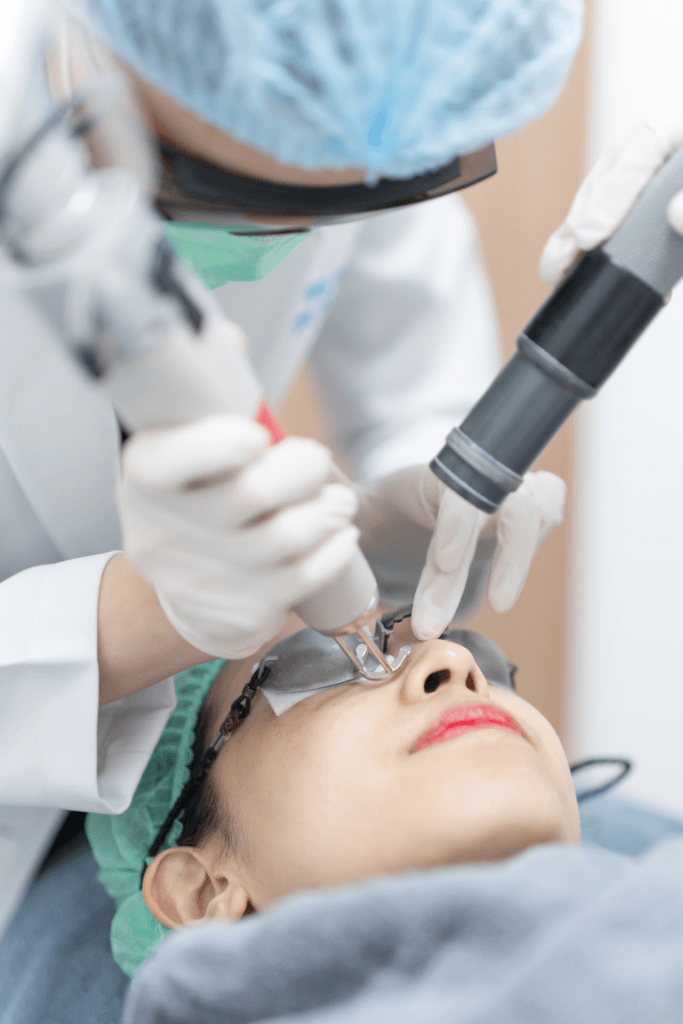
The photons are reflected back and forth within the diode structure, amplifying the light until it exits the diode as a focused, coherent laser beam.
What sets Smoothbeam apart is its dual-action approach. Not only does it address active acne by shrinking the sebaceous glands, but it also stimulates collagen production, which can help improve the appearance of acne scars over time. This makes Smoothbeam a comprehensive option for those dealing with both ongoing breakouts and the residual effects of past acne.
Smoothbeam is particularly well-suited for individuals with oily skin who are looking for a non-invasive treatment with minimal downtime. The procedure is generally well-tolerated, with most patients experiencing only mild redness or swelling that typically resolves within a few hours. A cooling spray is applied during the treatment to enhance comfort and protect the skin’s surface.
A typical Smoothbeam treatment plan involves 4-6 sessions spaced 3-4 weeks apart. This schedule allows for gradual and sustained improvement in acne symptoms, with many patients noticing a significant reduction in oiliness and breakouts after just a few sessions. The results are long-lasting, especially when combined with a good skincare routine tailored to your skin type.
Smoothbeam is an excellent choice for those seeking a targeted, non-invasive solution for oily, acne-prone skin. It’s particularly beneficial if you’re looking to reduce both active acne and the appearance of acne scars without the need for extensive downtime. As always, consult with a dermatologist to determine if Smoothbeam is the right option for your skin’s specific needs.
The Best Laser Treatment for Acne
The best laser treatment will depend on the type of acne that you are dealing with and which machines are available in your area. A dermatologist can help you decide whether or not you are a good candidate for laser treatments and which one to pursue. There are multiple great options for different types of acne.
Let’s break them down.
- Mild Acne: BBL Forever Clear, Aerolase Neo
- Moderate Acne: Aviclear, Smoothbeam, Alma Clear Skin
- Severe Acne: Accure
- Acne Scars: Lumenis M22
Is a laser treatment absolutely necessary? Only if you have tried multiple other avenues for treating your acne and have not yet found success.
Laser treatments are expensive and they are still not guaranteed to 100% clear up your acne. While many people have found success with laser treatments, there are others who experience frustratingly little change. It’s still a bit of a gamble to see how your skin will respond.
I would definitely start with a good skincare regimen, evaluate your diet, and consult with a dermatologist before making the leap into laser treatments.
Would you consider any of these laser treatments? Share your thoughts in the comments below!

